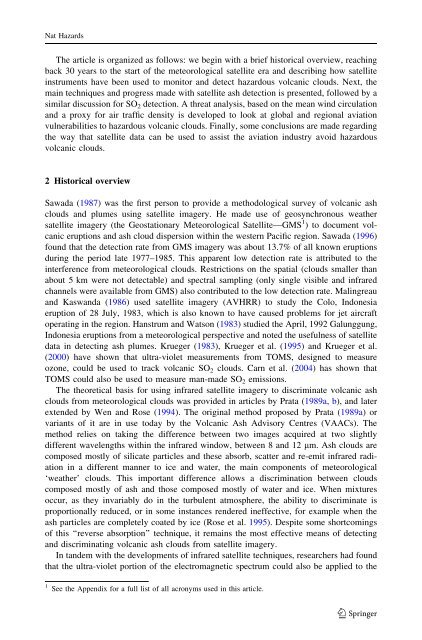Satellite detection of hazardous volcanic clouds and ... - Savaa - NILU
Satellite detection of hazardous volcanic clouds and ... - Savaa - NILU
Satellite detection of hazardous volcanic clouds and ... - Savaa - NILU
Create successful ePaper yourself
Turn your PDF publications into a flip-book with our unique Google optimized e-Paper software.
Nat HazardsThe article is organized as follows: we begin with a brief historical overview, reachingback 30 years to the start <strong>of</strong> the meteorological satellite era <strong>and</strong> describing how satelliteinstruments have been used to monitor <strong>and</strong> detect <strong>hazardous</strong> <strong>volcanic</strong> <strong>clouds</strong>. Next, themain techniques <strong>and</strong> progress made with satellite ash <strong>detection</strong> is presented, followed by asimilar discussion for SO 2 <strong>detection</strong>. A threat analysis, based on the mean wind circulation<strong>and</strong> a proxy for air traffic density is developed to look at global <strong>and</strong> regional aviationvulnerabilities to <strong>hazardous</strong> <strong>volcanic</strong> <strong>clouds</strong>. Finally, some conclusions are made regardingthe way that satellite data can be used to assist the aviation industry avoid <strong>hazardous</strong><strong>volcanic</strong> <strong>clouds</strong>.2 Historical overviewSawada (1987) was the first person to provide a methodological survey <strong>of</strong> <strong>volcanic</strong> ash<strong>clouds</strong> <strong>and</strong> plumes using satellite imagery. He made use <strong>of</strong> geosynchronous weathersatellite imagery (the Geostationary Meteorological <strong>Satellite</strong>—GMS 1 ) to document <strong>volcanic</strong>eruptions <strong>and</strong> ash cloud dispersion within the western Pacific region. Sawada (1996)found that the <strong>detection</strong> rate from GMS imagery was about 13.7% <strong>of</strong> all known eruptionsduring the period late 1977–1985. This apparent low <strong>detection</strong> rate is attributed to theinterference from meteorological <strong>clouds</strong>. Restrictions on the spatial (<strong>clouds</strong> smaller thanabout 5 km were not detectable) <strong>and</strong> spectral sampling (only single visible <strong>and</strong> infraredchannels were available from GMS) also contributed to the low <strong>detection</strong> rate. Malingreau<strong>and</strong> Kasw<strong>and</strong>a (1986) used satellite imagery (AVHRR) to study the Colo, Indonesiaeruption <strong>of</strong> 28 July, 1983, which is also known to have caused problems for jet aircraftoperating in the region. Hanstrum <strong>and</strong> Watson (1983) studied the April, 1992 Galunggung,Indonesia eruptions from a meteorological perspective <strong>and</strong> noted the usefulness <strong>of</strong> satellitedata in detecting ash plumes. Krueger (1983), Krueger et al. (1995) <strong>and</strong> Krueger et al.(2000) have shown that ultra-violet measurements from TOMS, designed to measureozone, could be used to track <strong>volcanic</strong> SO 2 <strong>clouds</strong>. Carn et al. (2004) has shown thatTOMS could also be used to measure man-made SO 2 emissions.The theoretical basis for using infrared satellite imagery to discriminate <strong>volcanic</strong> ash<strong>clouds</strong> from meteorological <strong>clouds</strong> was provided in articles by Prata (1989a, b), <strong>and</strong> laterextended by Wen <strong>and</strong> Rose (1994). The original method proposed by Prata (1989a) orvariants <strong>of</strong> it are in use today by the Volcanic Ash Advisory Centres (VAACs). Themethod relies on taking the difference between two images acquired at two slightlydifferent wavelengths within the infrared window, between 8 <strong>and</strong> 12 lm. Ash <strong>clouds</strong> arecomposed mostly <strong>of</strong> silicate particles <strong>and</strong> these absorb, scatter <strong>and</strong> re-emit infrared radiationin a different manner to ice <strong>and</strong> water, the main components <strong>of</strong> meteorological‘weather’ <strong>clouds</strong>. This important difference allows a discrimination between <strong>clouds</strong>composed mostly <strong>of</strong> ash <strong>and</strong> those composed mostly <strong>of</strong> water <strong>and</strong> ice. When mixturesoccur, as they invariably do in the turbulent atmosphere, the ability to discriminate isproportionally reduced, or in some instances rendered ineffective, for example when theash particles are completely coated by ice (Rose et al. 1995). Despite some shortcomings<strong>of</strong> this ‘‘reverse absorption’’ technique, it remains the most effective means <strong>of</strong> detecting<strong>and</strong> discriminating <strong>volcanic</strong> ash <strong>clouds</strong> from satellite imagery.In t<strong>and</strong>em with the developments <strong>of</strong> infrared satellite techniques, researchers had foundthat the ultra-violet portion <strong>of</strong> the electromagnetic spectrum could also be applied to the1 See the Appendix for a full list <strong>of</strong> all acronyms used in this article.123
















